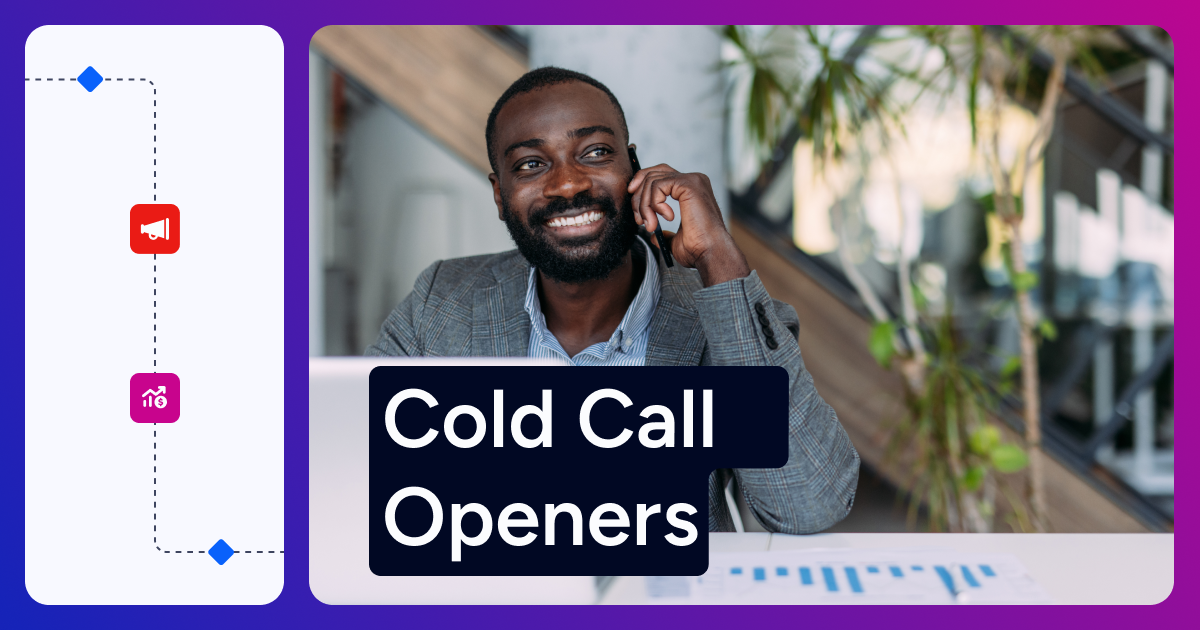In sales, your cold call opening can determine whether the conversation ends in seconds or leads to a successful meeting. The best cold opening lines establish trust, showcase professionalism, and position you as a credible partner.
We sourced advice from cold calling experts and real-world sales practitioners to give you the best tips and strategies for starting your cold calls.
Permission-Based Openers: Yes or No?
There is an ongoing debate about whether permission-based opening lines (think: “hey, do you have a few seconds?”) are the best approach for sales calls.
Many practitioners, like ZoomInfo account exec Greg Alexander, prefer asking for permission to ensure prospects are ready to listen. “If they say yes, they’re actually going to actively listen to what I have to say instead of me just pumping a bunch of stuff at them that they didn’t want to hear anyway,” Alexander says.
Other experts like ZoomInfo sales development manager Megan Huston take a different stance.
“For me, asking ‘Do you have a couple minutes?’ almost makes me feel like I’m devaluing myself and the value I bring to the conversation,” Huston says. She believes the prospect will cut you off if they truly don’t have time, so it’s better to confidently say what you came to say without immediately asking for permission.
Jason Bay, CEO of Outbound Squad, offers a middle-of-the-road perspective: “I lean pretty heavily into permission-based openers, but I’ve worked with equally as many reps that do all the things they say you’re not supposed to do in a cold call that have a lot of success too.”
This split highlights the importance of choosing a cold calling opening style that aligns with your personality and confidence. Some sales professionals prefer to get verbal buy-in before continuing, while others prefer to lead with value and let the prospect interrupt if needed.
Test both methods to see what works best with your tone, delivery, and target company personas.
Building Rapport and Trust with Your Opening Line
In cold calling, trust starts with your opening lines. And it’s not just what you say, but how you say it.
Tone
How do tone and delivery impact the effectiveness of a cold call?
“When it comes to your call opener, your tonality is probably 80% of it,” Bay says. And using a formal, corporate-sounding voice is one of the biggest mistakes he encounters when coaching. “People get on a call and transform into a different human.”
Huston agrees that your delivery matters as much as — if not more than— the words you use. “Your tonality and pacing take precedence, because you can’t properly convey what you’re trying to get across if that’s off,” she says.
ZoomInfo account executive Jack Moriarty has a tip: intentionally smile as you speak, even when the prospect can’t see you. It can help you deliver a tone that is warm, professional, and confident.
“It sounds like a cliche, but it does put an extra pep in my step,” he says.
Pacing
But a strong cold call opening is about more than just about avoiding customer service uptalk. It’s about pacing too.
Here’s why: Speaking too quickly can sound untrustworthy.
“If you’re trying to speak faster, it most likely means that you’re nervous,” Huston says. “Maybe you aren’t super confident in what you’re about to talk about. Maybe you don’t want your prospect to fully hear what you have to say, so you’re just trying to speed past it. “
On the other hand, a relaxed pace builds confidence. Slow, confident delivery makes prospects feel comfortable and respected.
Research
For example, “Hey, I noticed ABC Company just opened a plant in Detroit. Did I get that right?” This shows preparation, positions you as a professional, and begins the conversation with relevance to their company context.
Techniques for Handling Objections in Cold Calls From the Beginning
Objections are a natural part of cold calling. But if you start things off on the right foot, you can lessen the chances of facing big ones. Effective openers help prevent resistance from the beginning.
One way to head off objections: always give a reason for why you’re reaching out. Something as simple as congratulating them on recent funding or a promotion works. This ties your opening to something meaningful to them or the company, which builds credibility and softens objections.
When prospects feel understood, they’re less likely to push back.
Starting a “yes train” is another subtle strategy to soften up a prospect. Here’s how it works: confirm two or three things on the call that you can get a quick yes with (like: “Is this [name]?” and “Are you looking for ways to grow revenue right now?”). Use those small “yes” moments to get your prospect in a framework of positivity, creating an open mindset that can reduce resistance down the line.
Examples of Effective Cold Call Openers
What are the most effective cold call openers to grab attention?
Here are some of the best cold calling opening lines proven to work:
“Hey [Name], I’m hoping you can help me out really quick.”
This opener comes across as humble and disarming, shifting focus to your lead.
“Hi [Name], we work with other [industry] companies in [location]. Have you heard our name before?”
This line incorporates social proof early to build credibility.
“Hey [Name], this is [Seller Name] from [Company]. I know I’m catching you out of the blue. Do you have a few seconds?”
A permission-based opener acknowledges the interruption and secures willing participation.
“Hey [Name], I saw you just launched a new product at [Company]. Congrats – I was curious…”
Dropping relevance at the beginning uses immediate personalization to build rapport.
“Hey [name] Are you looking for any new business right now; is that a focus of yours?”
Using an easy question to open the conversation gets an almost certain “yes,” making subsequent “yeses” flow more easily.
“It looks like you head up [department] at [company]. Am I in the right place?”
This simple opening line ensures you’re contacting the correct person while also showing you did your basic sales prospect research.
“Hey [name], I’m calling about the hiring it looks like you’re doing in [location] right now. By the way, this is [Seller Name] with [company]. Do you have a minute? Promise to be brief.”
Mentioning company activity up front loads up on relevance at the beginning of the call
Remember, people just want a genuine conversation. So keep natural tonality, pacing, and confidence.
What Are Some Common Pitfalls to Avoid in Cold Call Openings?
Even with the best opening, some common cold call mistakes can shut down the conversation within seconds:
Talking too fast. Cold callers often rush through their opening lines, which makes prospects feel overwhelmed or suspicious. Slow down to sound confident and trustworthy.
Sounding overly salesy. Avoid the stereotypical high-energy sales voice. Aim for authentic, conversational tone instead.
Product dumping too early. Cold calling is not about listing every feature immediately. Focus on earning conversation time, not pitching everything at once.
Failing to confirm the contact. Ensure you’re speaking to the proper person before diving in.
Using generic openers without research. Prospects can tell when you haven’t done your homework. Incorporate relevant company details to build credibility.
Cold Calls Are All About Connection
Sales is about relationships and problem-solving. Your opening line should reflect empathy, relevance, and value.
When coaching her team, Huston always encourages them to remember that cold calling is just people calling people.
“I want them to think about what they would like to hear if they were the person being called,” she says. “To go into conversations not necessarily thinking ‘how can I have the best pitch,’ but more ‘how can I ask the best questions and be the best listener?’”
Once you’ve made that connection, the person on the other end of the line is more likely to listen, engage, and ultimately, be open to starting a meaningful business relationship.


